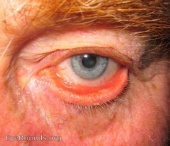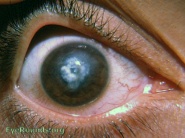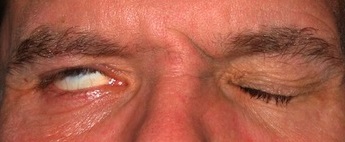Dry Eye
Keywords:[edit | edit source]
Generalized anxiety disorder, treatment, therapy, symptoms
Authors:[edit | edit source]
Dana Moorer, SPT & Kaelin Hocker, SPT
Abstract:[edit | edit source]
The exact cause of Generalized Anxiety Disorder is not fully understood. The current hypothesis is that neurotransmitters including serotonin, dopamine, and norepinephrine levels fluctuate, causing patients psychological state to change. The patient in the case study reported many clinical symptoms that can be misinterpreted for musculoskeletal deficits. Physical therapy cannot directly cure anxiety, since it is thought to be caused by neurotransmitters within the brain. However, physical therapists can help those who suffer from GAD be aware of their anxiety. The purpose of this case report is to report how physical therapy can’t cure GAD; however it can help reduce physical signs and symptoms associated with GAD.
Introduction:
Generalized Anxiety Disorder affects 3.1% of the U.S population. GAD is characterized by constant and excessive worrying, for at least six months or more. GAD can be considered a primary or secondary disorder, depending on the time of onset. Diagnosis at a young age is considered a primary disorder, and secondary is normally diagnosed later in life and is associated with other disorders. GAD is most often associated with other disorders that involve anxiety and depression and can lead to or worsen pre-existing conditions. Many of the bodies systems can be affected by GAD, including: Cardiopulmonary, Musculoskeletal, Gastrointestinal and Neurological systems. This disorder can manifest in several ways, incorporating physical, behavioral, and cognitive characteristics.
Case Presentation:[edit | edit source]
A 28 year-old Caucasian female presents to the clinic with complaints of joint pain (arthralgia) and intermittent low back pain. Patient cannot recall any mechanism of injury. She reports she has trouble falling asleep at night and is unable to get a good night’s rest. She often feels "restless" or "on edge", which she associates with not sleeping. She states she constantly worries about her performance in school, her family, and her mother’s health, who has recently been diagnosed with Stage IV Small Cell Carcinoma. Patient also states she wakes up at night with throbbing headaches that last for a couple hours. She feels tense the majority of the day, causing her to feel stiff. She also has difficulty paying attention in class and finishing her homework.
Subjective:[edit | edit source]
Joint pain, low back pain, headache, muscle stiffness, difficulty sleeping and paying attention for approximately a year. Previously diagnosed with PTSD and treated with CBT.
Demographic Information: Second Year Graduate Student, female, 28
Medical diagnosis if applicable: Diagnosed with PTSD in February of 2000.
Co-morbidities:[edit | edit source]
Hypertension, drinks 10+ alcoholic beverages per week (possible substance abuse), Depression
Previous care or treatment: PTSD treated with Cognitive Behavioral Therapy by Clinical Psychologist following car crash in 2000.
Self-Report Outcome Measures:[edit | edit source]
GAD-7 = 16/21, Penn State Worry Questionnaire (PSWQ) = 64/80, McGill Pain Questionnaire = 42/78
Physical Performance Measures:Oswestry Disability Index (ODI) = 38%
Objective:[edit | edit source]
Vitals: HR= 98 bpm (tachycardia), BP: 146/92 mmHg (hypertension), RR= 24 bpm. Palpable muscle tightness in upper trapezius, forward flexed head along with increased kyphosis. Patient appears to be profusely sweating and hands are cold and clammy to touch.
• Cervical AROM= limited extension and bilateral rotation
• Shoulder AROM= bilateral shoulder flexion decreased.
• All other shoulder AROM WFL.
• Myotomes= C1/C2, C2/C3 and C3/C4 weakness
• UE sensation intact
• LE AROM= limited trunk flexion/extension, along with knee flexion and ankle dorsiflexion deficits.
• Myotomes= L4/L5, L5/S1 weakness
• LE sensation intact
Clinical Impression:[edit | edit source]
¬ Hypertension
¬ Tachycardia
¬ Increased respiratory rate
¬ Red Flags:
Patient used phrases such as “restless and on edge” to describe her current state.
Patient has a significant medical history and suffered from PTSD and possible substance abuse, along with the stress of school and her mother’s health.
¬ Outcome Measures: Patient scored significantly high on the GAD-7, Penn State Worry Questionnaire & the McGill Pain Questionnaire.
¬ Limited AROM:
Cervical extension, cervical rotation, shoulder elevation, trunk flexion/extension, knee flexion and ankle dorsiflexion
¬ Myotome weakness: C1/C2, C2/C3, C3/C4, L4/L5, L5/S1
Intervention:[edit | edit source]
The scores from the outcomes measures revealed that the patient has signs and symptoms that are consistent with a moderately severe form of GAD. Therapist recommended that the patient follows up with her primary care physician to discuss the results of the outcome measures and see what approaches her physician recommends would be best for her since she has a significant medical history.
The therapist explained to the patient that physical therapy can not cure her possible GAD; however therapists can treat the symptoms through education because there is no specific physical therapy intervention to treat GAD.
Therapist provided educational information pertaining to anxiety management that the patient can utilize outside of therapy. Stress management techniques such as: mediation, deep breathing, progressive muscle relaxation techniques, exercise and modifying her diet. Therapist also discussed patient’s alcohol consumption and education on alcoholism and the effects it has on the mind and the body.
Outcomes:
After being diagnosed with GAD from her primary care physician, patient was referred back to PT for treatment of the musculoskeletal deficits secondary to GAD. Her primary care prescribed her Paxil to increase her levels of serotonin, which greatly improved her motivation for therapy. Within 2-3 weeks her AROM improved and the scores on her outcome measures decreased significantly.
GAD-7 = 10/21
Penn State Worry Questionnaire = 48/80
McGill Pain Questionnaire = 31/78
Discussion:[edit | edit source]
There is limited research on physical therapy interventions to directly treat GAD. However, physical therapy can be very effective when treating musculoskeletal impairments that are secondary to GAD. An important role physical therapists can take is patient education. By educating patients about sticking to an adherent medical regimen (medication schedule) that can help improve patient compliance and can educate the patient on the complexity of their condition. Also, teaching the patient relaxation techniques, such as deep breathing exercises and massage techniques can help to decrease muscle tension. Exercise is another way that physical therapists can aid in reducing anxiety and significantly improve cardiovascular health. Physical therapy when combined with other interventions such as cognitive behavioral therapy and holistic approaches can significantly improve the overall quality of life in patients suffering from GAD.
Related Pages:[edit | edit source]
http://www.physio-pedia.com/Generalized_Anxiety_Disorder
References:[edit | edit source]
1. Goodman CC and Snyder TK. Differential Diagnosis for Physical Therapists: Screening for Referral. 4th edition. St. Louis, Missouri: Saunders Elsevier, 2007.
2. Katzman M. Current Considerations in the Treatment of Generalized Anxiety Disorder. CNS Drugs. 2009; 23: 103-120. Available from: ProQuest Medical Library. Accessed March 23, 2017, Document ID: 1658393961.
3. Kavan M., Elsasser G., Barone E. Generalized Anxiety Disorder: Practical Assessment and Management. American Family Physician. 2009; 79:785-791, 9-10.
4. Medical Foundation for Medical Education and Research. Mayo Clinic: Depression and anxiety: Exercise eases symptoms. http://www.mayoclinic.com/health/depression-and-exercise/MH00043. Updated October 10, 2014. Accessed March 27, 2017.
5. Medical Foundation for Medical Education and Research. Mayo Clinic: Serotonin and Norepinephrine Reuptake Inhibitors (SNRIs). http://www.mayoclinic.com/health/antidepressants/MH00067. Updated December 10, 2008. Accessed March 24, 2017.
Dry Eye (in Facial Palsy)[edit | edit source]
Individuals with Facial Palsy frequently encounter problems with the affected eye being dry.
This is caused by lack of tear production in the affected eye, causing a dry, possibly painful eye, with risk of corneal ulceration.
In Facial Nerve palsy there are 2 problems which contribute towards making the eye dry:
1. The greater petrosal nerve, derived from the facial nerve, supplies the parasympathetic autonomic component of the lacrimal gland. - controlling production of moisture/tearing in eyes.
2. The zygomatic branch of the Facial Nerve supplies Orbicularis Oculi, and the resulting paralysis causes inability(or reduced ability) to close the eye or blink, so the tears (or indeed artificial lubrication in the form of drops, gel or ointment) are not spread across the cornea properly.
The following efffects may be observed:
- The widening of the distance between the upper and lower eyelids, technically described as a "widened palpebral fissure".
- The loss of blink reflex and inability to close the eyelid, due to impaired orbicularis oculi function, can lead to excessive dryness of the cornea, "exposure keratopathy".
- The lower eyelid may turn upwards (a condition known as paralytic eyelid ectropion). When associated with upper and lower lid retraction, this prevents the eyelids from closing to cover the eye completely. (The medical term for this is lagophthalmos).
- Dysfunctional lacrimation (abnormal flow of tears); the overflow of tears onto the face (known as epiphora) being further increased by the absence of lower lid nasal twist – as the nasal twist helps pump tears into the lacrimal drainage system.
Ectropion of lower eyelid Corneal ulcer
Symptoms caused by Dry Eye[edit | edit source]
Symptoms may include:
- Gritty, burning or scratchy feeling in the eye
- Redness of the eye
- Feeling of dryness in the eye
- Pain in the eye
- Blurred vision
- Frequent eye infections
- Corneal damage
- Excessive watering of the eye - confusingly, this can occur for short periods of time in an otherwise dry eye
Other factors which can exacerbate Dry Eye[edit | edit source]
- Age: Dry occur can occur in the elderly even without any damage to the facial nerve
- Medical conditions: Rheumatoid Arthritis, diabetes, Parkinson's Disease and thyroid problems can all cause Dry Eye syndrome. In addition conditions such as seborrhaeic dermatitis and blepharitis can affect the tear production and exacerbate Dry Eye.
- Medications: antihypertensives, antihistamines and antidepressants can all reduce tear production.
- Gender: women can be more susceptible to Dry Eye syndrome due to hormonal changes, eg. at menopause, during pregnancy or when taking oral or injected contraception.
Management of Dry Eye[edit | edit source]
It is important to stress to the patient the risks of Dry Eye in Facial Palsy: ie. that it can lead to formation of a corneal ulcer, which in turn can cause loss of vision in the affected eye.
Any Facial Palsy patient with an acutely red and sore eye should attend their local Eye Hospital or local A & E as soon as possible.
It is also essential to establish whether the eye is closing fully at night. Often the patient reports that it is, as they are "in the dark" when they close their eyes. But this does NOT mean that they have full eye closure: often they have little or no eye closure but do have a strong "Bell's Phenomenon" where the eyeball rolls upward. This means that they think the eye is closed, as they no longer see anything out of it, but in fact there is incomplete closure, and the white of the eye is clearly visible to the clinician. The easiest way to convince the patient that they need to tape their eye closed at night is to take a photograph of the eye in what they think is complete closure.
Below is a photograph of Bell's Phenomenon:
Advice[edit | edit source]
- If they do not have full eye closure then advise them to tape the eye closed overnight, and apply lubrication in the form of Lacri-Lube ointment
- During the day, advise regular use of lubricating drops or gel
- Protect the eye from winds, so when walking outside in windy weather it is helpful to wear wrap-around style sunglasses
- Avoid air conditioning as much as possible (switch off the air-con in the car!) as this dries out the eye
Botulinum Toxin[edit | edit source]
A dose of Botulinum Toxin ("Botox") to cause a temporary ptosis (closure) of the eye is sometimes employed in cases of dense facial palsy, when the eye is a high risk of corneal ulceration.
Surgical Interventions[edit | edit source]
Remember, if your Facial Palsy patient is in the 1st few weeks (or even months in some cases) of onset, once the nerve has chance to regrow and respond to your physiotherapeutic interventions the Dry Eye is likely to improve enormously, due to improved eye closure and increased blink activity. Therefore, the following surgical techniques may not be required in these cases.
However, if the person has a chronic long term flaccid facial palsy, the following interventions may be indicated:
- Upper eyelid weight implantation: a small weight is placed into the upper eyelid. When the person automatically blinks the paralysed eye, the weight helps it to close
- Tarsorraphy: the corner (usually the lateral corner) of the eye is stitched together, thus narrowing the palpebral fissure
- Lateral canthoplasty: this procedure shortens the muscle and tendon at the outer corner of the eyelid, preventing the lower eyelid falling away from the eye
- Punctal Plugs: tiny silicone plugs are inserted into one or both of the 2 drainage channels in the eye, resulting in the tears/artificial lubrication staying in the eye for longer, thus increasing moisture









